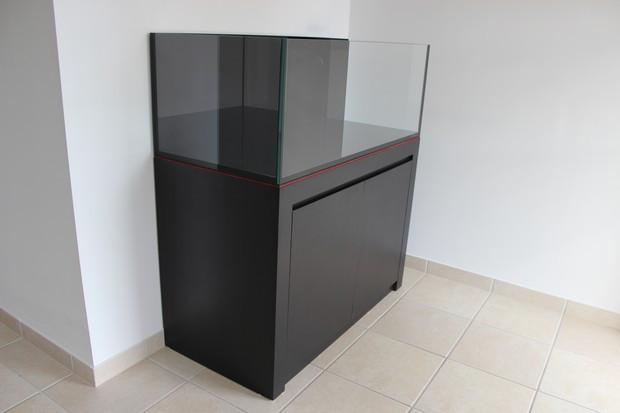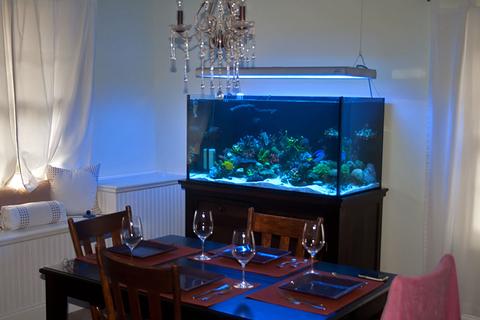Thank you for visiting! By the way… any links on this page that lead to products on Amazon and other stores/partners are affiliate links Aquarium Store Depot earns a commission if you make a purchase.
An Aquarium stand can come in a variety of shapes, sizes, and materials. In any aquarium, an the stand is an integral piece of a complete setup. This is particularly importantly in a saltwater aquarium due to the fact that the vast majority of hobbyists will place a sump in the stand so the stand will function at the back-end operations of the aquarium. This article should provide you some in-depth detail the 5 things you should know about an aquarium stand so you can make the best decision for your aquarium.
#1 Know the Type of Aquarium Stand
Before I can get into more detail about aquarium stands, we need to address the various types of aquarium stands you will come across. When shopping for an aquarium stand, there is a high amount of variety in quality. When it comes to a saltwater aquarium and larger freshwater aquariums, the importance of quality needs to be taken into account. and when it comes to the needs of a saltwater aquarium. The importance of quality needs to be taken into account. We are going to break down stands into four types:
- Standard Aquarium Stands – AKA big store stands
- Brand Name Stands
- Custom Built Stands
- DIY Stand
A standard aquarium stand is ones you will commonly find in a general pet store or online like the All Glass Pine Stands. They are typically made of particle board and MDF. Many of these stands are made as cheap as possible. While they can work in a freshwater setup or no sump setups, they will not suit the needs of a saltwater tank or larger freshwater aquarium in the long run. The reason why is because if a sump is installed the stand, the high humidity produced inside the tank from the sump can cause wrapping from the inside of the stand. Furthermore, spills inside of the stand from maintenance can also cause problems. Once the warping occurs, the damage cannot be reversed and can compromise the structure of the stand. It is for these reasons, that I do not recommend a standard aquarium stand from general pet stores for a saltwater or larger freshwater setup. There is simply too much investment made into your tank setup for it to be ruined by going cheap on a stand.
A cleaner and more modern looking stand over the old all glass stands
A brand name stand is furniture made by high-end manufacturers who specialize in making stands for hobbyist. The best example of these stands would be the stands that you find in all-in-one aquariums and rimless aquarium kits. These stands are very well designed with a wood or metal frame (typically aluminum or stainless steel). If they are wood, they will usually be designed with plywood instead of MDF. They will often have features that suit the hobby (Storage shelves, cable ports, etc). A common brand at fish stores are R&J Enterprises cabinets, which are a step up from the chain store cabinets. These stands are great choices for anyone getting into the hobby.
UNS are top of the line aquarium stands designed for planted tanks
A stand is typically built by custom aquarium manufacturers or Brand name specializing in high-end builds. They are typically made to order and are the most expensive types of aquarium stand. They can be made of wood or metal. They will typically be designed with customized cabinet doors and shelves to suit the requirements of the aquarium. They are of superior quality, but suited for a high-end budget.

Custom Fish Stands are Usually Built for Maximum Utility
#2 Know the Materials
There are several types of materials for a stand that you should be familiar with when looking at either purchasing or building your own:
- MDF/Particle Board
- Plywood
- Metal
MDF or particle board is the cheapest type of wood used for stand manufacturing. It is commonly used with store chain brand stands or stands that are imported. They usually do not hold up in a saltwater aquarium because of the high humidity from your sump or wrapping over time. MDF would only be okay to use if you are either hiring a carpenter to build your stand or you are familiar with woodworking and know how to paint and seal it.
Plywood is the standard when it comes to quality aquarium stand building. It is typically used in higher-end branded stands and is the go-to material if you are considering a DIY stand. Plywood is a very strong building material and less susceptible to water damage than MDF. Plywood is also the material used to build higher-end kitchen cabinets due to its durability. It is stainable and several veneers are available for you to produce a custom look. They can be painted or sealed and the quality of the material will stand the test of time.
A metal stand is typically used for larger aquariums. They have great structural support and a mix of metal and wood can be used to build a custom stand. Because of the greater structural strength, a metal stand will be more open which will increase your access to your sump and back-end electronics stored in your stand. Metal frames are usually made with stainless steel or aluminum. Aluminum is particularly popular outside of the US, but is gaining traction in the US as they are lightweight. A stand built from T-Slot Aluminum Framing Systems is particularly useful for those attempting a custom build for a large aquarium – though can be very expensive.
 Metal Stands are Typically Used for Large Custom Aquariums
Metal Stands are Typically Used for Large Custom Aquariums
#3 Know about Openings and Stand Heights of your Tank
In general, a stand will be open at the top. While this will work well for glass aquariums, you will need to support the entire bottom of the tank if it is made of acrylic. For rimless aquariums, it is recommended that you purchase a self-leveling mat. This is because, in a rimless aquarium, the wood can cause pressure points in the glass. Many manufacturers will sell the support needed for an acrylic and rimless tank. It is helpful to have an opening at the top if you are going to place a sizable sump as sometimes when the sump is placed in the stand, it will be impossible to move out of the aquarium stand once your tank is installed.
Another consideration when purchasing or making a stand is the amount of room available for equipment underneath the aquarium. Large door openings and plentiful space help in hiding the amount of equipment associated with reef aquariums. If you plan on keeping a sump under your aquarium, you will need to consider having enough room to hold all your equipment and sump while still having room to maintain it. One of the main disadvantages of many standard aquarium stands is that they have a brace in the middle of the stand that will get in the way of maintenance. Many high-end and DIY aquarium stand configurations do not have this brace.
The height of the stand will also impact your viewing enjoyment. Ask yourself if you are going to be spending most of your viewing time standing or sitting. A standard sized aquarium stand is built for viewing while sitting down and will usually be shorter than 30 inches. Many of the all-in-one aquariums and higher end aquarium stands these days will have taller stands – usually 30 to 36 inches. Most DIYers will also build a stand to 36 inches in height.
#4 Consider a DIY for Maximum Utility
Making a stand versus purchasing one is a serious consideration for experienced reefers or those with carpentry skills. Purchasing a stand is typically going to be more expensive, but you will not have to worry about constructing the stand yourself and if you are following this guide it is very likely you will end up purchasing a high-quality stand that will last throughout your aquarium journey.
For those of you considering a DIY aquarium stand, most of the DIY stands are constructed out of wood. Below is a picture frame and guide from the reefcentral forums by member RocketEngineer. This is a 21 piece design that has been used by many reefers who have ventured into DIY stands. This is a simple yet solid design that can be created with the use of common tools and common wood sizes and should work for most standard size aquariums:

If you want more of a step by guide to building a custom stand, you can check out GARF’s stand calculator. This calculator is a great tool as all you do is enter in your desired dimensions and the calculator will product a cut list, tools needed, and assembly instructions.
When painting your stand, considering sealing the inside of your stand with a Spar or Marine Varnish. An oil based primer is ideal.
#5 Canopy or No Canopy
With the advent of rimless aquariums and ceiling and tank mounted lighting systems, the canopy is starting to become less common these days. It’s really up to you regarding the look of your aquarium. Not purchasing a canopy can save you some money, but there are still a number of hobbyists who still use them. If you are concerned about fish jumping out of your tank with a topless system, you can opt for mesh screening to prevent jumping.
 Top-Less Setups are More Common Now with Rimless Aquariums
Top-Less Setups are More Common Now with Rimless Aquariums
Closing Comments
I hope this guide provides you with a lot of insights on what to look for when it comes to selecting a quality aquarium stand. A stand in a key part of your aquarium and needs to stand the test of time. Please share and thank you for reading.
- About the Author
- Latest Posts
I’m thrilled that you found Aquarium Store Depot! Here you’ll find information on fish, aquariums, and all things aquatics related. I’m a hobbyist (being doing this since I was 11) and here to help other hobbyists thrive with their aquariums! I adhere to a high quality Editorial Process and Review products with real life field usage and practical analysis.





 Metal Stands are Typically Used for Large Custom Aquariums
Metal Stands are Typically Used for Large Custom Aquariums Top-Less Setups are More Common Now with Rimless Aquariums
Top-Less Setups are More Common Now with Rimless Aquariums



I bought a used 100 gallon acrylic tank and it came with and acrylic base. The base seems fairly sturdy but I’m a bit concerned about it being made out of acrylic. Any thoughts?
As in an acrylic stand? Never seen one myself personally. Acrylic does need to be supported through the entire bottom of the tank otherwise it would risk breakage.
Hi Mark. We want to start another aquarium and are considering a stand from ikea. It’s not mdf- it’s actual wood but it would look beautiful in our space. I’m not sure about wight displacement and am sure it would rest well on the edges but the front has no vertical post like most stands. In the cat the front is essentially the frame for two sliding doors. Thoughts? https://www.ikea.com/us/en/p/havsta-cabinet-with-base-white-70388620/
Hi George. It depends on the size of your aquarium. I wouldn’t put anything larger than a 20 gallon tank on it
Hi Mark,
I am purchasing a Planet aquarium 150 gallon tanks that measures 48.5 by 24.5. Is it okay to make a stand that is larger than these dimensions? I’m thinking of having an aluminum stand made. The reason I want to know if the stand can be larger is because my sump will measure about 55 to 60 inches with everything in it and a conventional stand won’t accomodate this. I have only seen stands that exactly match the tank but it is that only for aethetics of a leveling issue? Thank you so much
It is fine to make a stand larger than the dimensions. The main thing is you want an even surface for the aquarium to lay on if it’s a rimless. You will want a safe leveling mat too. Aluminum stands will have open areas like many wood stands so you will need to work with your manufacturer to ensure you can put a mat on it.
Thank you so much! That was my next question because there are a lot of open spaces in the construction. I was wondering do I place a board on top then a leveling mat? I appreciate this forum because there really isn’t a lot of info on stands.
Hi Jason,
Yes you can put a board on top then a leveling mat. That’s a pretty standard thing to do with a rimless install :).
Hi hoping this gets read 😂
I have a aquavogue 135l cabinet that measures 80cm in length and 43cm in depth. I have just got a Roma 125l which measures same in length but is short on depth at 35cm – will this be OK to put on top?
Thank you
Hi Emily. I’m not familiar with those manufacturers. I’m in the US. Those seem like European tank manufacturers. I would check with them.
Hello, so I work at a welding and fab shop, I recently built a stand out of steel for a 125 gallon tank. I like the look of steel and wood together so was going to put wood on the top of it where the aquarium sits on it. I know or hear a lot of people say don’t use 2 by 6’s because it can flex the tank? Is that true? I screwed the 2 by 6’s from underneath and there all good and flush with each other. Would it be safer to use a yoga mat of some sort underneath the tank? Thanks
Hi Michael,
I would need more details to understand what you built. Is this a rimless or rimmed tank? If it is a rimmed tank, it shouldn’t matter as a rimmed glass tank can stand on cider blocks and be fine.
For a rimless and acrylic aquariums, you will need support throughout the bottom. The surface also needs to be level and smooth. Make sure the surface is smooth and use a leveling mat like yoga mat material to put on top of the wood so the aquarium can sit on it.
Hi Mark- Thank you for this post! I have a 10 gallon tank and I want to build a stand that is about 48” tall. Will you tell me the beat way to do this? Should the legs be angled out so as to hold the weight better and not tip over? Have you seen a freestanding tank that is this tall? Thank you.
Best,
Magi
Hi Magi,
I the tallest I’ve seen has been 42″ for a DIY stand. Anything taller was usually built by a carpenter, or they opt’ed for an in wall install. If you use the same principle as RocketEngineer’s picture, I feel you should be okay. The good thing with a 10 gallon tank that its weight is not that much. I would have concerns if this was a 200+ gallon tank
Hi
I only have a 8 gallon tank, but because of normal water spillage, the cheap wood chips came quick and drastic and look ugly. I bought at big box stores. I can’t do DIY. Is what is left a custom build?
Hi Gail. For a tank that small you can use a stand from a store that uses wood and treat it or you can hire a carpenter locally to do it. A lot of local reefers make them for others. That’s how I usually get mine for my larger builds
Hello, how many gallons and what are the dimensions of the tank just above #2 please?
That’s a 6 foot long tank. Don’t recall the DIMS or gallons though. It was over 180 gallons